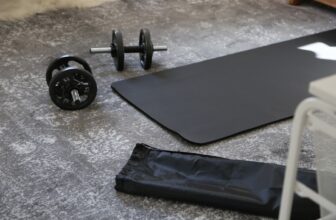
When you embark on a fitness journey, the significance of an effective fitness program cannot be overstated. It serves as the foundation upon which your health and wellness aspirations are built. An effective program is not merely a collection of exercises; it is a structured approach that aligns with your personal goals, lifestyle, and physical capabilities.
By understanding the importance of such a program, you can set yourself up for success, ensuring that your efforts yield tangible results. An effective fitness program provides you with a roadmap, guiding you through the myriad of options available in the fitness world. It helps you avoid the pitfalls of random workouts that may lead to frustration or injury.
With a well-designed program, you can focus on specific outcomes, whether that’s weight loss, muscle gain, or improved endurance. This clarity allows you to channel your energy and motivation into activities that truly matter, making your fitness journey more rewarding and enjoyable.
Key Takeaways
- Effective fitness programs are important for overall health and well-being
- Setting realistic goals is crucial for a successful fitness journey
- Choosing the right fitness program that aligns with your body and goals is essential
- Incorporating variety and progression in workouts helps to avoid plateaus and boredom
- Balancing cardio, strength training, and flexibility is key for a well-rounded fitness program
Setting Realistic Goals for Your Fitness Journey
Setting Achievable Goals
Instead of aiming for drastic changes in a short period, consider setting smaller, incremental goals that can lead to sustainable progress over time. This approach not only fosters a sense of accomplishment but also helps you build confidence in your abilities.
Defining Your Objectives
When establishing your fitness goals, take the time to reflect on what you genuinely want to achieve. Are you looking to lose weight, build muscle, or enhance your overall health? By identifying your primary objectives, you can create a more targeted plan.
Creating a Balanced Strategy
Additionally, consider incorporating both short-term and long-term goals into your strategy. Short-term goals can provide immediate motivation, while long-term goals keep you focused on the bigger picture. Remember, the journey is just as important as the destination, so celebrate each achievement along the way.
Choosing the Right Fitness Program for Your Body and Goals

Selecting the right fitness program is a pivotal step in your journey toward better health. With countless options available, it’s essential to choose one that aligns with your body type, fitness level, and personal goals. Start by assessing your current physical condition and any limitations you may have.
This self-awareness will help you identify programs that are suitable for your needs and prevent potential injuries. Consider exploring various types of fitness programs, such as strength training, cardio workouts, or group classes. Each program offers unique benefits and can cater to different preferences.
For instance, if you thrive in social settings, group classes may provide the motivation and camaraderie you need to stay committed. On the other hand, if you prefer solitude and self-paced workouts, a personalized strength training regimen might be more appropriate. Ultimately, the right program should resonate with you and inspire you to stay engaged in your fitness journey.
Incorporating Variety and Progression in Your Workouts
| Workout Type | Frequency | Intensity | Duration |
|---|---|---|---|
| Cardio | 3-5 times per week | Moderate to high | 30-60 minutes |
| Strength Training | 2-3 times per week | High | 30-60 minutes |
| Flexibility and Mobility | 2-3 times per week | Low to moderate | 15-30 minutes |
To maintain enthusiasm and prevent plateaus in your fitness journey, incorporating variety and progression into your workouts is essential. Repeating the same routine can lead to boredom and diminished results over time. By introducing new exercises or changing the order of your workouts, you can keep things fresh and exciting.
This variety not only challenges your body in different ways but also helps prevent overuse injuries. Progression is equally important in ensuring that you continue to see improvements in your fitness level. As you become stronger or more conditioned, it’s vital to increase the intensity or complexity of your workouts.
This could mean lifting heavier weights, increasing the duration of your cardio sessions, or trying more advanced movements. By consistently pushing your limits, you’ll stimulate muscle growth and enhance your overall performance. Remember that progression doesn’t always have to be drastic; even small increments can lead to significant changes over time.
Balancing Cardio, Strength Training, and Flexibility in Your Program
A well-rounded fitness program should include a balance of cardio, strength training, and flexibility exercises. Each component plays a vital role in promoting overall health and wellness. Cardio workouts are essential for improving cardiovascular health and burning calories, while strength training builds muscle mass and boosts metabolism.
Flexibility exercises enhance mobility and reduce the risk of injury, making them an integral part of any fitness regimen. To achieve this balance, consider scheduling specific days for each type of workout or incorporating elements of all three into each session. For example, you might start with a cardio warm-up, followed by strength training exercises, and conclude with stretching or yoga.
This approach not only keeps your workouts diverse but also ensures that you’re addressing all aspects of fitness.
Tracking and Monitoring Your Progress

Tracking your fitness progress is essential to achieving your goals. It allows you to reflect on your journey, identify what works for you, and make adjustments as needed.
Why Tracking Progress Matters
By keeping a record of your workouts, measurements, and achievements, you can gain valuable insights into your progress. This practice not only helps you stay accountable but also allows you to celebrate milestones along the way.
Methods for Tracking Progress
There are various methods for tracking progress, from traditional journals to mobile apps designed specifically for fitness enthusiasts. Choose a method that resonates with you and fits seamlessly into your routine.
The Benefits of Regular Review
Regularly reviewing your progress can help identify patterns or areas where you may need to refocus your efforts. Additionally, seeing how far you’ve come can serve as a powerful motivator during challenging times when your commitment may waver.
Seeking Professional Guidance and Support
While embarking on a fitness journey can be empowering, seeking professional guidance can enhance your experience significantly. Personal trainers or fitness coaches possess the expertise to help you navigate challenges and tailor programs specifically to your needs. They can provide valuable feedback on your form during exercises, ensuring that you’re performing movements safely and effectively.
Moreover, professional support can offer accountability that is often difficult to maintain on your own. Having someone who understands your goals and encourages you to push through obstacles can make a world of difference in your motivation levels. Whether it’s through one-on-one sessions or group classes led by experienced instructors, investing in professional guidance can accelerate your progress and deepen your understanding of fitness principles.
Making Lifestyle Changes to Support Your Fitness Program
To truly succeed in your fitness journey, it’s essential to make lifestyle changes that support your program. Fitness is not just about what happens in the gym; it encompasses every aspect of your daily life. Start by evaluating your nutrition habits—fueling your body with wholesome foods will provide the energy needed for effective workouts and recovery.
Additionally, consider other lifestyle factors such as sleep quality and stress management. Adequate rest is crucial for muscle recovery and overall well-being; aim for 7-9 hours of quality sleep each night. Incorporating stress-reducing practices like meditation or yoga can also enhance your mental resilience during challenging times in your fitness journey.
By making these holistic lifestyle changes, you’ll create an environment conducive to achieving your fitness goals while fostering long-term health and happiness. In conclusion, embarking on a fitness journey requires careful consideration of various factors that contribute to success. From understanding the importance of effective programs to setting realistic goals and seeking professional guidance, each step plays a vital role in shaping your experience.
By incorporating variety into your workouts and balancing different aspects of fitness while making supportive lifestyle changes, you’ll be well-equipped to navigate the challenges ahead and achieve lasting results on your path to better health.
If you are looking to enhance your fitness program, you may want to consider incorporating jump ropes into your cardio workouts. According to a recent article on sunsethealthandfitness.com, jump ropes can be a highly effective tool for improving cardiovascular health and burning calories. By adding this simple yet challenging exercise to your routine, you can boost your endurance and agility while also having fun.


